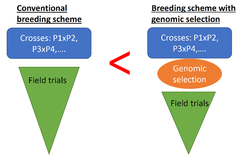New Publication [15.04.15]
Genomic selection in wheat: optimum allocation of test resources and comparison of breeding strategies for line and hybrid breeding C. Friedrich H. Longin, Xuefei Mi, Tobias Würschum Theoretical and Applied Genetics, April 2015, DOI 10.1007/s00122-015-2505-1Genomic selection in wheat:  optimum allocation of test resources and comparison of breeding strategies for line and hybrid breeding
optimum allocation of test resources and comparison of breeding strategies for line and hybrid breeding
Key message
The implementation of genomic selection in breeding programs can be recommended for hybrid and line breeding in wheat.
Abstract
High prediction accuracies from genomic selection (GS) were reported for grain yield in wheat asking for the elaboration of efficient breeding strategies applying GS. Our objectives were therefore, (1) to optimize the number of lines, locations and testers in different multi-stage breeding strategies with and without GS, (2) to elaborate the most efficient breeding strategy based on the selection gain and its standard deviation, and (3) to investigate the potential of GS to improve the relative efficiency of hybrid versus line breeding in wheat. We used the open source software package “selectiongain” to optimize the allocation of resources in different breeding strategies by predicting the expected selection gain for a fixed budget. Classical two-stage phenotypic selection was compared with three GS breeding strategies for line and hybrid breeding in wheat. The ranking of the alternative breeding strategies varied largely in dependence of the GS prediction accuracy. Fast-track breeding strategies based solely on GS were only advantageous for high GS prediction accuracies that is >0.50 and >0.65 for hybrid and line breeding, respectively. However, a GS prediction accuracy across breeding cycles of 0.3 or even less must be assumed as realistic for grain yield in wheat. For this low GS prediction accuracy, the use of GS is advantageous for line but especially for hybrid breeding in wheat. Furthermore, the use of GS in hybrid wheat breeding increased the relative efficiency of hybrid versus line breeding and, thus, might be an important pillar for the establishment of hybrid wheat.


